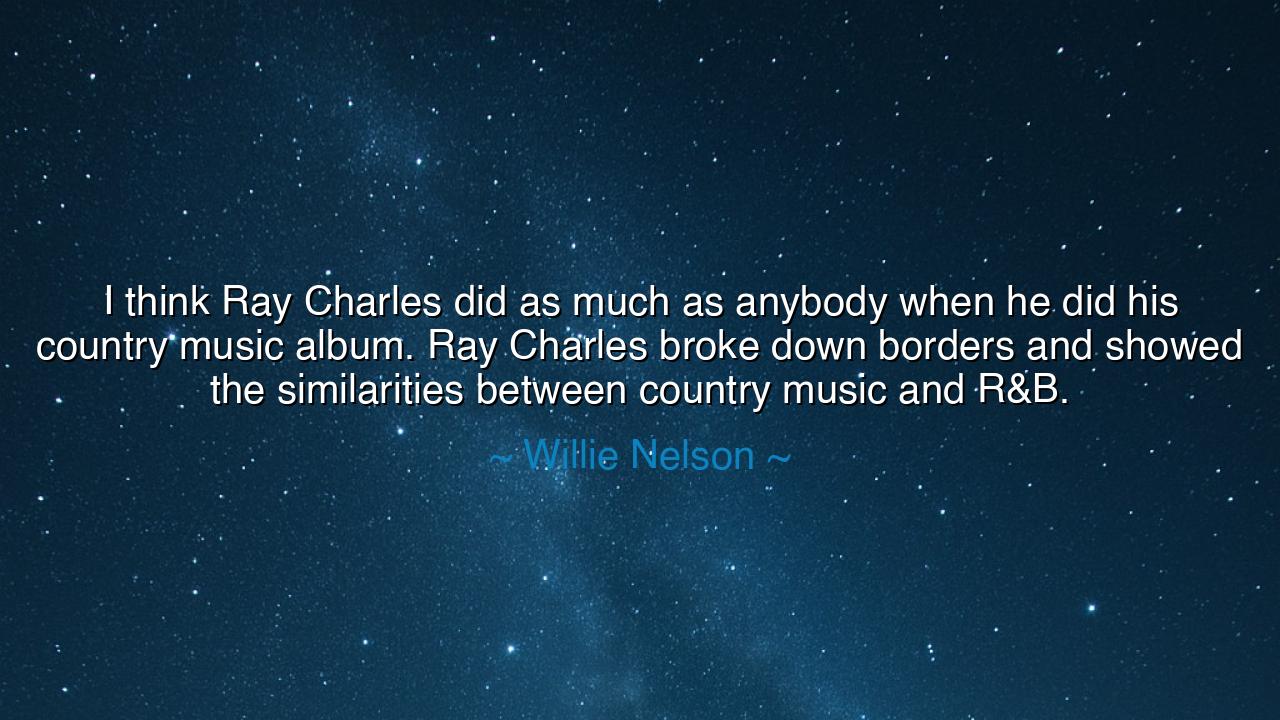
I think Ray Charles did as much as anybody when he did his
I think Ray Charles did as much as anybody when he did his country music album. Ray Charles broke down borders and showed the similarities between country music and R&B.






“I think Ray Charles did as much as anybody when he did his country music album. Ray Charles broke down borders and showed the similarities between country music and R&B.” Thus spoke Willie Nelson, a poet of the American songbook, and his words strike like a hymn across the ages. For in them lies a truth as old as humanity itself: that the divisions men build are but illusions, and that the power of art—like the power of love—knows no boundaries. Music, whether called country or R&B, flows from the same well of human longing, and Ray Charles, in his boldness, revealed this unity.
The ancients often taught that the river has many streams, yet all return to the sea. So it is with music. Cultures may name their songs differently, may clothe them in varied instruments, rhythms, and dialects, but beneath it all beats the same heart: joy and sorrow, yearning and triumph, grief and celebration. What Ray Charles achieved with his album Modern Sounds in Country and Western Music was to tear away the veil of separation, showing that country and R&B, though thought to be worlds apart, were siblings born of the same soul.
In the days of its release, such a fusion was radical. America itself was divided—by race, by class, by region. Country music was seen as the voice of the rural South, of white traditions, while R&B was tied to Black communities, carrying the rhythms of struggle and resilience. To many, the two worlds seemed destined never to meet. Yet Ray Charles, blind in sight but gifted with vision of the heart, wove them together into one tapestry. He sang country with the inflections of soul, and in so doing, showed that beneath the labels lay a common humanity.
Consider how this mirrors the work of other bridge-builders in history. Think of Alexander the Great, who, though a conqueror, did not merely crush the cultures he encountered but fused them, creating the Hellenistic age where Greek, Egyptian, and Eastern traditions mingled. Or recall Duke Ellington, who brought the music of Harlem’s jazz clubs into the grand halls of Europe, refusing to let it be confined by borders of race or class. Like them, Ray Charles proved that true art is not imprisoned by barriers, but expands to embrace all who will listen.
The lesson of Willie Nelson’s words is clear: when courage meets creativity, walls fall. What the world calls separate can be united; what the world calls “different” can be revealed as kin. It takes only one daring spirit to step into the space between, to risk criticism, and to sing a new truth. Ray Charles did this—not for fame, not for applause, but to reveal through melody and soul that we are not as divided as we believe.
O children of tomorrow, take this teaching into your hearts. Do not be deceived by the false borders of culture, color, or creed. Look deeper, and you will see that every song, every story, every soul shares in the same rhythm of life. Dare to be like Ray Charles—step beyond the lines drawn by others, and seek the harmony hidden beneath division. For when you do, you not only create art, you heal the world.
In your own life, this means seeking connection where others see separation. Learn from those unlike yourself. Embrace traditions beyond your own. Blend your skills, your voice, your spirit with others, and you will discover strength greater than any you could carry alone. Let the critics call it foolish; in time, they will call it vision.
Thus let Willie Nelson’s words endure: “Ray Charles broke down borders.” Remember this, and know that borders are but fences of the mind, while music, like love, is eternal and boundless. Walk bravely beyond them, and you too may reveal the unity that waits, hidden, in the heart of all things.






AAdministratorAdministrator
Welcome, honored guests. Please leave a comment, we will respond soon